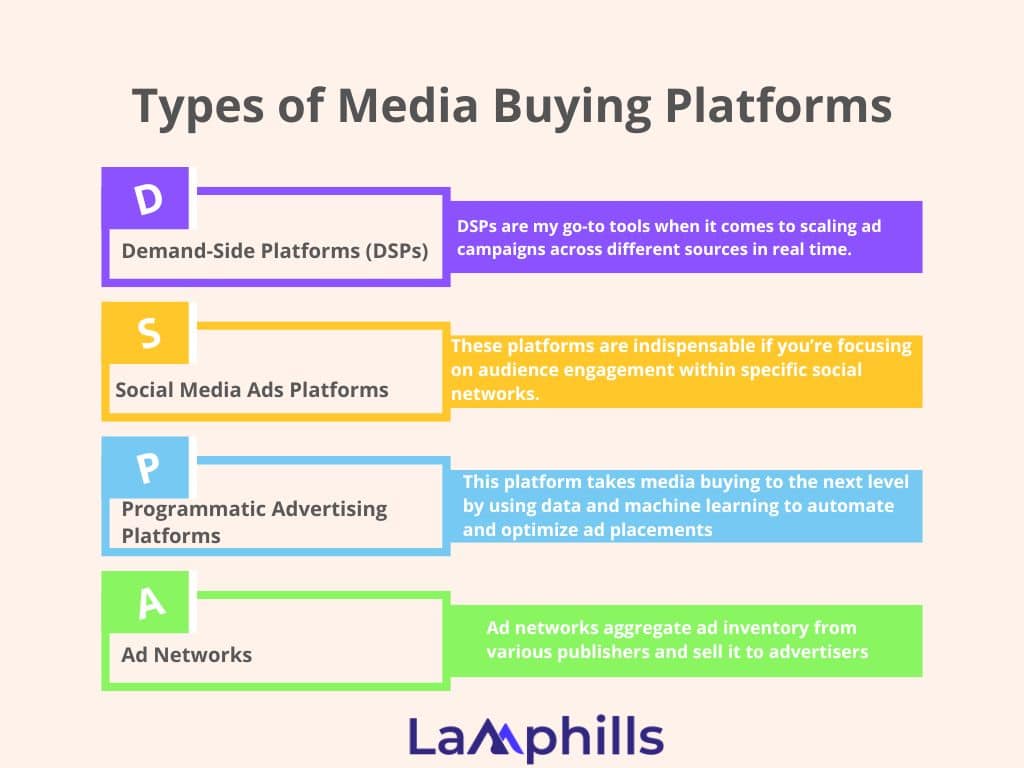Choosing the right media buying platform can make or break your advertising success. With countless platforms promising unmatched reach and targeting, how do you pick the one that fits your brand’s goals? In this guide, we’ll break down the top 10 media buying platforms to help your brand stand out, scale faster, and connect with the right audience. To what end? I just want to ensure you make the most of your advertising budget. Ready to make a decision that can drive real impact? Let’s analyze media buying platforms that revolutionized digital advertising.
Key Points
- Media buying is purchasing ad placements across digital or traditional channels to reach a specific audience.
- Effective media buying allows businesses to maximize reach, increase visibility, and drive conversions.
- Ad networks, demand-side platforms (DSPs), social media ad platforms, and programmatic advertising platforms.
- TikTok Ads, Taboola, Amazon DSP, LinkedIn Ads, Facebook Ads Manager, and Google Ads are some of the best media buying platforms.
What Is Media Buying and Why Does It Matter?
Media buying is purchasing ad placements across digital or traditional channels to reach a specific audience. Unlike organic marketing, media buying involves paying for exposure, ensuring your brand’s message is seen by the right people at the right time.
Effective media buying allows businesses to maximize reach, increase visibility, and drive conversions. In 2023 alone, companies in the US spent over $260 billion on digital ads, according to Statista, underscoring how vital media buying has become for brand success.
Understanding Media Buying Platforms
A media buying platform is a tool that helps advertisers buy digital ad space on websites, apps, or social media. It makes placing ads easier by automating things like finding the best spots for the ads, deciding when and where they should appear, and targeting the right audience. With these platforms, advertisers can reach several people while staying within their budget, rather than negotiating ad placements individually.
Types of Media Buying Platforms

The following are the main types of media buying platforms:
#1. Demand-Side Platforms (DSPs)
DSPs are my go-to tools for scaling ad campaigns across different sources in real time. Advertisers use DSPs to purchase ad inventory across multiple sources. DSPs allow for automated bidding on ad placements and help target specific audiences across various channels, including websites, apps, and social media. Examples include Google’s Display & Video 360, The Trade Desk, and Adobe Advertising Cloud.
#2. Social Media Ad Platforms
These platforms are indispensable for audience engagement within specific social networks. Each platform— Facebook Ads Manager, LinkedIn Campaign Manager, or TikTok Ads—offers robust targeting options. Advertisers tailor campaigns to users’ unique behaviors on each network. I’ve found Facebook Ads Manager to be one of the most versatile in delivering targeted, cost-effective campaigns.
#3. Programmatic Advertising Platforms
This platform takes media buying to the next level by using data and machine learning to automate and optimize ad placements. Programmatic advertising platforms often integrate with DSPs and ad exchanges. For instance, Google Ads and AppNexus provide excellent programmatic capabilities that ensure your ads are served based on data-driven insights.
#4. Ad Networks
Ad networks aggregate ad inventory from various publishers and sell it to advertisers. They connect advertisers with publishers to enable them to reach large audiences. Examples include Google AdSense, Taboola, and Outbrain.
Key Factors to Consider When Choosing Media Buying Platforms
The following are some of the factors to consider when choosing media buying platforms:
#1. Budget Flexibility
Different platforms cater to different advertising budgets. Some platforms, like Google Ads, allow small budgets, while others, like Amazon DSP, require higher investment. Be sure to align your choice with your budget. So considering budget flexibility can determine which platform suits your brand.
#2. Ad Format Availability
Which ad format do you prefer? Display ads, video ads, or native content? Your choice of ad format should align with your brand’s message and audience preference. For example, platforms like TikTok Ads Manager might be more suitable if you’re targeting a younger, video-loving audience.
#3. Targeting Capabilities
If you will reach the right audience, there’s a need for advanced audience targeting. Look for platforms with robust targeting features based on demographics, interests, and behavior. Platforms such as Facebook Ads Manager offer granular targeting options, allowing you to filter audiences by age, interests, location, and behaviors.
#4. Analytics and Reporting
Analytics and reporting must be one of the basis of media buying strategies. Detailed reporting helps you understand how well your ads are performing. Ensure the platform offers comprehensive insights and analytics that allow you to measure success and optimize campaigns.
#5. User Experience
The ease of use is something many brands overlook. The platform should be easy to use, even for beginners, and offer support resources such as tutorials, chat assistance, or account managers. For instance, AdRoll is known for its user-friendly interface, while MediaMath might require more expertise to navigate.
How to Choose the Right Media Buying Platform for Your Brand
Having a hard time deciding which platform is perfect for your media buying efforts? The guide below will be of help to you:
#1. Understand Your Goals
Why do you want to invest in media buying? If your goal is brand awareness, Google Ads or Facebook Ads are perfect for mass reach. On the other hand, Amazon DSP or Criteo might be better suited for conversion. So, start by defining your primary objectives.
#2. Know Your Audience
Your audience determines everything. A B2B brand should consider LinkedIn Ads, while a youth-focused brand might thrive on TikTok Ads Manager.
#3. Align with Your Budget
Budget flexibility is key. Some platforms, like AdRoll, allow smaller budgets, whereas Trade Desk may require higher spending.
#4. Test and Optimize
It’s always better to test platforms before investing in it. So, run small-scale campaigns to see what works before committing to a full-scale campaign. Use the data to optimize and refine your strategy.
Best Media Buying Platforms
The following are some of the best media buying platforms:
#1. Google Ads
Google Ads is the giant in the media buying world, giving brands access to over 90% of internet users through its search engine, display network, and YouTube. This platform offers a wealth of ad formats, from text-based search ads to visually rich display and video ads, making it suitable for brands of all sizes. Whether you’re promoting local services, products, or global campaigns, Google Ads can serve your needs.
It’s suitable for brands of all sizes that want to leverage the immense reach of Google, from small businesses with modest budgets to global enterprises. If you’re running a campaign focused on driving leads or sales, Google Ads should be at the top of your list. For instance, a real estate company looking to generate leads for luxury properties can use search ads with targeted keywords, while a lifestyle brand can use YouTube video ads to create awareness.
“Google Ads is the go-to platform for businesses that want visibility on the world’s largest search engine. It offers robust targeting options, making it one of the most versatile tools in digital marketing today.” – John Doe, PPC Specialist.
Key Features of Google Ads
- Search Ads: Appear at the top of Google search results.
- Display Ads: Banner and rich media ads that appear across websites in the Google Display Network.
- Video Ads: Run on YouTube and its partner sites.
- App Campaigns: Promote mobile apps across Google’s platforms.
#2. Facebook Ads Manager
With over 3 billion monthly active users, Facebook Ads Manager is a social media powerhouse. It gives advertisers access to the vast Facebook network, which includes Facebook itself, Instagram, Messenger, and the Audience Network. The platform is ideal for advertisers who want to engage users in a more social and interactive environment.
The following are some of the features of Facebook Ads Manager:
- Audience Targeting
- Instagram Ads
- Lookalike Audience
- Dynamic Ads
#3. LinkedIn Ads
LinkedIn Ads is the go-to platform for B2B marketers, giving them access to over 900 million professionals across various industries. The platform excels at lead generation, thanks to its ability to target users by job title, industry, company size, and more.
For instance, a software-as-a-service (SaaS) company looking to target HR directors or IT managers at large enterprises can use LinkedIn Ads to run highly targeted campaigns based on job title, company size, and even specific companies.
#4. Amazon DSP
Amazon DSP (Demand-Side Platform) allows advertisers to programmatically buy display, video, and audio ads on and off Amazon’s platforms. With access to Amazon’s first-party data, advertisers can target users based on their shopping habits, making it a favorite for e-commerce brands.
If you’re an electronics brand and want to retarget users who viewed your products on Amazon, Amazon DSP allows you to serve display ads across its network, reminding them to complete the purchase.
“Amazon DSP gives advertisers an unparalleled edge, especially in e-commerce. The ability to leverage real-time shopping data makes targeting more accurate and conversion rates higher.” Sarah Martinez, Ecommerce Strategist
Key Features of Amazon DSP
The following are some of the features of Amazon DSP:
- Retargeting: Target users who have previously viewed or purchased products on Amazon.
- First-Party Data: Leverage Amazon’s vast consumer data for better targeting.
- Omnichannel Reach: Run ads on Amazon.com, Fire TV, Kindle, and even third-party websites.
Why Should You Consider Amazon DSP?
The following are some of the reasons why l love Amazon DSP:
- Unmatched consumer data: Amazon’s ability to tap into consumer purchasing data gives advertisers a unique advantage.
- Retargeting powerhouse: You can retarget consumers who have interacted with your brand or specific products.
- Effective for conversions: Since you’re advertising to users who are already intent on buying, conversion rates tend to be higher.
Amazon DSP drawbacks include:
- High minimum ad spend
- Complex interface
#5. Taboola
Taboola is a native advertising platform that places your content within the flow of editorial content on major publisher sites. Its strength lies in content discovery, allowing you to serve ads in a non-intrusive way that blends seamlessly with the content a user is already reading.
For instance, a travel company can use Taboola to promote blog content about top travel destinations. The company can drive traffic to their blog, and nurture potential customers before pushing them toward booking by placing native ads on high-traffic news sites.
The following are some of the features of Taboola:
- Native Ads: Appear as sponsored content on major publishers, driving traffic to your website.
- Video Ads: Engage users through short, attention-grabbing video content.
- Content Recommendation: Uses algorithms to recommend content to users on trusted sites.
Why Should I Choose Taboola?
Below are some of the strengths of Taboola:
- Non-intrusive
- High-quality publishers
- Great for top-of-funnel
Taboola’s Drawback Include:
- Lower conversion rates
- Limited targeting
#6. TikTok Ads
TikTok has exploded as one of the most popular platforms for younger audiences, with over 1 billion active users worldwide. It allows brands to create engaging short-form video content that aligns with the platform’s highly visual, fast-paced format. It’s an ideal platform for brands to engage younger audiences with creative, entertaining content. It’s also great for consumer goods, fashion, beauty, and entertainment industries.
Key Features of TikTok Ads
The following are some of the features of TikTok Ads:
- In-Feed Ads: Videos that appear in users’ feeds as they scroll through content.
- Branded Hashtag Challenges: Engage users by encouraging them to create their content using branded hashtags.
- TopView Ads: Full-screen ads that appear when users open the TikTok app.
Why TikTok Ads is Ideal for You?
Titktik ads is great because of the reasons below:
- High engagement
- Viral potential
- Creative freedom
Read Also: A Guide to Paid Media Management: Best Strategies
Lamphills Media Buying Campaign Planner Template
With this template, marketers can plan and organize their media buying campaigns efficiently.
Download Lamphills Media Buying Campaign Planner Template
Read Also: A Comprehensive Guide to Digital Media Buying in 2024
Programmatic Media Buying Platforms
The following are some of the best programmatic media buying platforms:
#1. Google Display & Video 360
Google Display & Video 360 (DV360) is a powerful tool that integrates various Google advertising products into one seamless platform. What sets DV360 apart is its robust data capabilities. Users can access first-party and third-party data to enhance targeting precision. Due to its advanced optimization feature, businesses that use DV360 have seen an average increase of 30% in their return on ad spend (ROAS). One industry expert noted, “With DV360, the depth of targeting and analytics provides advertisers an edge in today’s competitive market.”
Below are some of the key features of Google Display & Video 360:
- Unified Campaign Management: DV360 allows advertisers to manage display, video, and audio campaigns from a single interface.
- Advanced Targeting Options: Use audience insights from Google Analytics and custom segments to reach specific demographics and interests.
- Creative Management: Users can create, test, and optimize creatives within the platform, ensuring that the most effective ads are served.
#2. The Trade Desk
The Trade Desk is a leading demand-side platform known for its user-friendly interface and extensive inventory access. It empowers marketers to buy and manage digital advertising campaigns across various channels, including display, video, audio, and social. A recent report highlighted that Trade Desk users experience a 20% increase in engagement rates compared to traditional buying methods. “The Trade Desk’s approach to programmatic advertising allows for unparalleled agility in campaign management,” says a seasoned digital marketer.
The following are some of the top features of the Trade Desk:
- Real-Time Bidding: The platform offers sophisticated bidding algorithms that adjust in real time based on performance data. Generally, this ensures optimal ad placement.
- Comprehensive Analytics: Users can access in-depth reporting and analytics tools that help evaluate campaign performance and make data-driven decisions.
- Cross-Device Capabilities: Advertisers can track and engage users across multiple devices, enhancing the chances of conversions.
#3. MediaMath
MediaMath is another key player in the programmatic advertising landscape, known for its robust technology stack and focus on transparency. This platform is designed to help marketers maximize their ad spend while maintaining full control over their data. According to a study, MediaMath users report a 15-25% improvement in ad performance due to its data integration capabilities. As one analyst put it, “MediaMath’s transparency and control over ad spend create a powerful advantage for marketers looking to maximize ROI.”
The following are some of the key features of MediaMath:
- Omnichannel Reach: MediaMath supports multiple ad formats, including display, video, and mobile, allowing for a cohesive advertising strategy across channels.
- Open Ecosystem: It enables marketers to leverage data from various sources, facilitating better audience targeting and personalization.
- Integrated Data Solutions: Users can tap into rich datasets to refine their targeting strategies and optimize campaign performance.
#4. AdRoll
AdRoll stands out for its focus on retargeting and cross-channel marketing, making it an ideal choice for businesses looking to re-engage potential customers. The platform simplifies retargeting, which enables advertisers to serve ads to users who have previously interacted with their brand. Recent user feedback highlights a significant increase in conversion rates, with some businesses seeing up to a 40% boost after implementing AdRoll’s retargeting strategies. “AdRoll’s ability to keep your brand top-of-mind is invaluable in today’s fast-paced digital landscape,” states a marketing executive.
The following are some of the key features of AdRoll:
- Dynamic Ads: AdRoll offers customizable ad templates that can automatically pull product images and information from e-commerce sites, enhancing personalization.
- Multi-Channel Campaigns: Advertisers can seamlessly run campaigns across the web, social media, and email, providing a holistic approach to customer engagement.
- User-Friendly Dashboard: The intuitive interface makes it easy for users to set up campaigns and track performance without extensive technical knowledge.
#5. AppNexus (now Xandr)
AppNexus recently rebranded as Xandr, offers a comprehensive suite of tools for buyers and sellers interested in programmatic advertising. Its strong emphasis on technology and innovation makes it a go-to platform for advertisers seeking efficiency and performance. Advertisers using Xandr experience a 30% higher fill rate on their ad inventory than standard programmatic platforms. As one industry insider remarked, “Xandr’s commitment to transparency and innovation sets a new standard for programmatic buying.”
The following are some of the key features of Xandr:
- Powerful Analytics Tools: Xandr provides deep insights into campaign performance, enabling marketers to optimize in real-time.
- Seamless Integration: The platform easily integrates with various data management platforms (DMPs) and customer relationship management (CRM) systems for enhanced targeting.
- Private Marketplace (PMP): Advertisers can access premium inventory through exclusive deals, ensuring higher visibility and lower competition.
What Are the 3 Owned Media Platforms?
The 3 owned media platforms are websites/blogs, email lists/newsletters, and social media accounts.
What Is the Most Powerful Media Platform?
Google is often considered the most powerful media platform due to its dominance in search, advertising (Google Ads), and its vast ecosystem, including YouTube.
What is the Most Profitable Media Company?
As of recent data, Alphabet Inc. (Google’s parent company) is the most profitable media company, largely due to its advertising revenue from Google and YouTube. Other major players include Meta (Facebook) and Disney.
Related Articles
- How to Calculate Social Media Impressions in 2024
- A Comprehensive Guide to Digital Media Buying in 2024
- 25 Powerful Advertisement Examples You Should Take Inspiration From
- My Key Strategies for Building an Effective Social Media Kit + Templates





